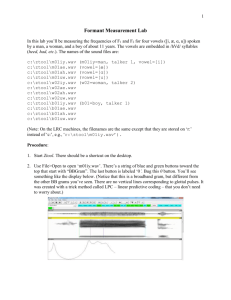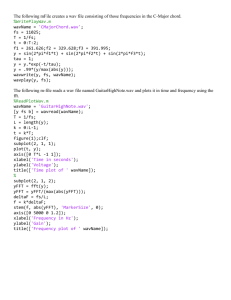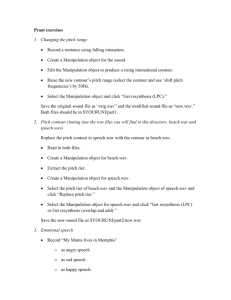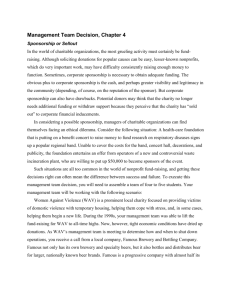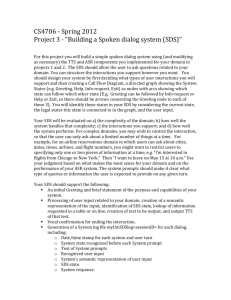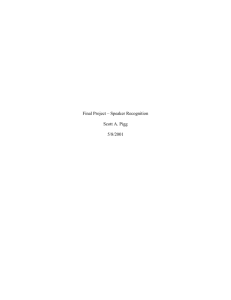Voice recognition project
advertisement
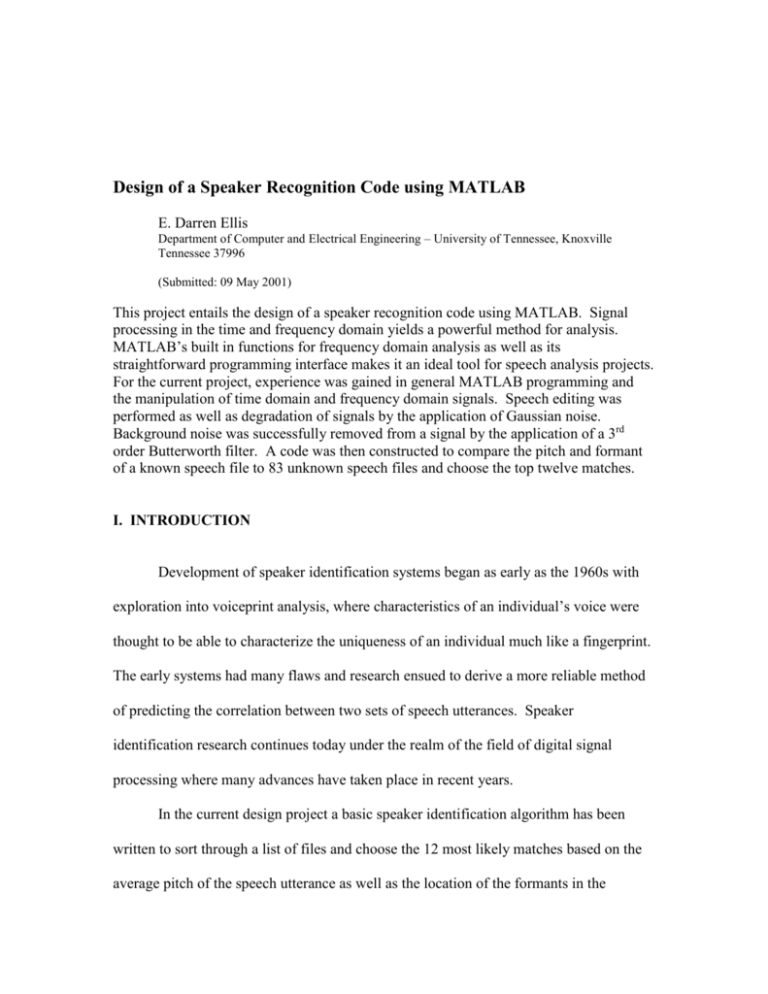
Design of a Speaker Recognition Code using MATLAB
E. Darren Ellis
Department of Computer and Electrical Engineering – University of Tennessee, Knoxville
Tennessee 37996
(Submitted: 09 May 2001)
This project entails the design of a speaker recognition code using MATLAB. Signal
processing in the time and frequency domain yields a powerful method for analysis.
MATLAB’s built in functions for frequency domain analysis as well as its
straightforward programming interface makes it an ideal tool for speech analysis projects.
For the current project, experience was gained in general MATLAB programming and
the manipulation of time domain and frequency domain signals. Speech editing was
performed as well as degradation of signals by the application of Gaussian noise.
Background noise was successfully removed from a signal by the application of a 3rd
order Butterworth filter. A code was then constructed to compare the pitch and formant
of a known speech file to 83 unknown speech files and choose the top twelve matches.
I. INTRODUCTION
Development of speaker identification systems began as early as the 1960s with
exploration into voiceprint analysis, where characteristics of an individual’s voice were
thought to be able to characterize the uniqueness of an individual much like a fingerprint.
The early systems had many flaws and research ensued to derive a more reliable method
of predicting the correlation between two sets of speech utterances. Speaker
identification research continues today under the realm of the field of digital signal
processing where many advances have taken place in recent years.
In the current design project a basic speaker identification algorithm has been
written to sort through a list of files and choose the 12 most likely matches based on the
average pitch of the speech utterance as well as the location of the formants in the
frequency domain representation. In addition, experience has been gained in basic
filtering of high frequency noise signals with the use of a Butterworth filter as well as
speech editing techniques.
II. APPROACH
This multi faceted design project can be categorized into different sections:
speech editing, speech degradation, speech enhancement, pitch analysis, formant analysis
and waveform comparison. The resulting discussion will be segmented based on these
delineations.
SPEECH EDITING
The file recorded with my slower speech (a17.wav) was found from the ordered
list of speakers. A plot of this file is shown in Figure (1). It was determined that the
length of the vector representing this speech file had a magnitude of 30,000. Thus the
vector was partitioned into two separate vectors of equal length and the vectors were
written to a file in opposite order. The file was then read and played back. The code for
this process can be found in Appendix A.
SPEECH DEGRADATION
The file recorded with my faster speech (a18.wav) was found from the ordered list
of speakers. Speech degradation was performed by adding Gaussian noise generated by
the MATLAB function randn() to this file. A comparison was then made between the
clean file and the signal with the addition of Gaussian noise. The code for this process
can be found in Appendix B.
0.12
Plot of a17.wav in the time domain
0.1
0.08
Amplitude
0.06
0.04
0.02
0
-0.02
-0.04
-0.06
-0.08
0
0.5
1
1.5
2
Time, (s)
2.5
3
3.5
4
Fig 1. Time domain plot of a17.wav.
SPEECH ENHANCEMENT
The file recorded with my slower speech and noise in the background (a71.wav)
was found from the ordered list of speakers. A plot of this file is shown in Figure (2).
This signal was then converted to the frequency domain through the use of a shifted FFT
and correctly scaled frequency vector. The higher frequency noise
0.4
Plot of a71.wav in the time domain
0.3
Amplitude
0.2
0.1
0
-0.1
-0.2
-0.3
0
0.5
1
1.5
2
Time, (s)
2.5
3
3.5
4
Fig 2. Time domain plot of a71.wav.
components were then removed by application of a 3rd order Butterworth low pass filter,
Eq.(1), with the cutoff chosen to remove as much of the noise signal as possible while
still preserving the original signal.
H B (u, v)
1
1 ( 2 1)( D(u, v) Do ) 2 n
(1)
where D(u,v) is the rms value of u and v, Do determines the cutoff frequency, and n is the
filter order. The Butterworth filter is a reasonable choice to use as it more closely
approximates an ideal low pass filter as the order, n, is increased.
The resulting filtered signal was then scaled and plotted with the original noisy
signal to compare the filtering result. The code for this process can be found in
Appendix C.
PITCH ANALYSIS
The file recorded with my slower speech (a17.wav) was found from the ordered
list of speakers. Pitch analysis was conducted and relevant parameters were extracted.
The average pitch of the entire wav file was computed and found to have a value of
154.8595 Hz. The graph of pitch contour versus time frame was also created to see how
the pitch varies over the wav file, Figure (3). The results of pitch analysis can be used in
speaker recognition, where the differences in average pitch can be used to characterize a
speech file. The code for this process can be found in Appendix D.
180
Pitch Contour Plot
160
140
Pitch, (Hz)
120
100
80
60
40
20
0
0
100
200
Fig 3. Pitch contour plot.
300
400
Time Frame, (arb.)
500
600
700
FORMANT ANALYSIS
Formant analysis was performed on my slow speech file (a17.wav). The first five
peaks in the power spectral density were returned and the first three can be seen in Figure
(4). Also, the vector position of the peaks in the power spectral density were calculated
and can be used to characterize a particular voice file. This technique is used in the
waveform comparison section. The code for this process can be found in Appendix E.
WAVEFORM COMPARISON
Using the results and information learned from pitch and formant analysis, a
waveform comparison code was written. Speech waveform files can be characterized
based on various criteria. Average pitch and formant peak position vectors are two
-25
Formant Plot
-30
Amplitude, (dB)
-35
-40
-45
-50
-55
-60
0
0.1
0.2
0.3
0.4
0.5
0.6
0.7
Arbitrary Frequency Scale, (arb.)
Fig 4. Plot of the first few formants of a17.wav.
0.8
0.9
1
such criteria that can be used to characterize a speech file. The slow speech file
(a17.wav) was used as a reference file. Four sorting routines were then written to
compare the files. The sorting routines performed the following functions: sort and
compare the average pitch of the reference file with all 83 wav files, compare the formant
vector of the reference file to all wav files, sort for the top 20 average pitch correlations
and then sort these files by formant vectors, and finally to sort for the top 20 formant
vector correlations and then sort these by average pitch. Sample code for the case of
comparing the average pitch and then comparing the top 12 most likely matches by
formant peak difference vectors is given in Appendix F. The three other cases use code
from this sample to achieve their results.
III.
RESULTS
Results of speech editing are shown in Figure (5). As can be seen, the phrase “ECE310,” the second half of the first plot, has clearly been moved to the front of the
waveform in the second plot.
Speech degradation by the application of Gaussian noise can be seen in Figure (6).
The upper plot shows the signal from wav file a18.wav in the time domain. The middle
plot yields a frequency domain view of the same wav file. The bottom plot allows for a
comparison between the clean signal (middle plot) and one with Gaussian noise added to
it. Results of the speech enhancement routine can be seen in Figure (7). The upper plot
shows the file a71.wav with natural background noise. The noise signal is more
0.1
Time domain plot of a18.wav
0
-0.1
0
0.5
1
1.5
2
2.5
30
Frequency domain plot of a18.wav
20
10
0
-1
30
-0.8
-0.6
-0.4
-0.2
0
0.2
0.4
0.6
0.8
1
4
Frequency domain plot of a18.wav with noise added
x 10
20
10
0
-1
-0.8
-0.6
-0.4
-0.2
0
0.2
0.4
0.6
0.8
1
4
x 10
Fig 5. File a18.wav with and without Gaussian noise added to it.
0.15
Original speech file, a17.wav. Signals and systems, ECE-310
Amplitude
0.1
0.05
0
-0.05
-0.1
0
0.5
1
1.5
2
Time, (s)
2.5
3
3.5
4
0.15
Edited Speech file, ECE-310 moved before Signals and Systems
Amplitude
0.1
0.05
0
-0.05
-0.1
0
0.5
1
1.5
Fig 6. Example of speech editing.
2
Time, (s)
2.5
3
3.5
4
0.5
file a71.wav with natural background noise
0
-0.5
0
0.5
1
1.5
2
2.5
3
3.5
4
150
Shifted FFT of a71.wav showing
noise
100
50
0
-1.5
150
-1
-0.5
0
0.5
1
1.5
4
x 10
Shifted FFT of a71.wav after
100 application of 3rd order Butterworth
Filter.
50
0
-1.5
-1
-0.5
0
0.5
1
1.5
4
x 10
Fig 7. File a71.wav. Comparison of natural and LPF filtered signal.
prevalent in the middle figure which shows the shifted FFT of the original signal. The
noise can be seen as a broad peak at approximately 1x104 Hz, as well as an overall
background component. The bottom figure shows the signal after application of a 3rd
order Butterworth filter and amplitude scaling to yield a valid comparison to the original
signal.
The results of pitch analysis were used in the waveform comparison section of the
speech recognition project. The results of the average pitch of all four of my speech files
are summarized in Table (1).
Table 1. Summary of pitch characteristics.
Wav File Name
A17.wav
Average Pitch (Hz)
154.8595
Characteristic of Wav File
Slow speech
A18.wav
158.4562
Fast speech
A71.wav
154.8068
A52.wav
188.0342
Slow speech with
background noise
Slow speech, different
phrase
As can been seen from Table (1), the average pitch varies for faster speech
utterances as well as for different phrases. The addition of background noise affects the
average pitch very little, however, speaking a different phrase produces a change of
greater than 30 Hz.
A plot of the Power spectral density, Figure (8), for my four speech files shows
the location of the first few formants present in each file. Good agreement between the
peak locations of file a17.wav and a18.wav is seen in the first and second plots, where the
same phrase is spoken but at different rates. However, file a71.wav, with the background
noise shows a large background component over a wide frequency range and shields the
location of some of the lower amplitude peaks. Also, the last plot of the PSD of a phrase
different than the upper three plots shows the location of the formant peaks slightly
shifted in frequency, as would be expected. One of the routines used in the waveform
comparison section of the project calculates the vector difference between peak locations
in the PSD and compares this vector to the same characteristic of all the other wav files
-20
PSD plot of a17.wav
-40
-60
-20
0
0.1
0.2
0.3
0.4
0.5
0.6
0.7
0.8
0.9
1
0.5
0.6
0.7
0.8
0.9
1
0.5
0.6
0.7
0.8
0.9
1
0.6
0.7
0.8
0.9
1
PSD plot of a18.wav
-40
-60
0
0
0.1
0.2
0.3
0.4
PSD plot of a71.wav
-50
-100
-20
0
0.1
0.2
0.3
0.4
PSD plot of a52.wav
-40
-60
0
0.1
0.2
0.3
0.4
0.5
Fig 8. Comparison of PSD of the wav files.
.
In order to create a speech recognition algorithm, criteria to compare speech files
must be established. This section of the project compares four different methods of
comparing the data. First, the wav files are compared to a reference file and sorted based
on the average pitch of the file only (Method 1). The files were then compared and
sorted based entirely on the location of the formants present in the PSD of the signal
(Method 2). A third method compared the average pitch present and ranked the matches
in ascending order and then compared the top 12 most likely matches by formant location
in the PSD (Method 3). Finally, the inverse routine was performed where the files were
compared and sorted by the location of the formants present and then the top 12 most
likely matches based on this data were compared and sorted by pitch (Method 4). Table
(2) compares the results of this work.
Table (2). Comparison of the four different comparison methods.
Method
1
a17.wav
a71.wav
My file?
(*)
*
Method
2
a17.wav
My file?
(*)
*
Method
3
a17.wav
My file?
(*)
*
Method
4
a17.wav
a12.wav
a63.wav
a63.wav
a19.wav
a07.wav
a65.wav
a65.wav
a08.wav
a52.wav
a73.wav
a63.wav
a73.wav
a03.wav
a63.wav
a72.wav
a8.wav
a07.wav
a15.wav
a53.wav
a19.wav
a12.wav
a01.wav
a03.wav
a14.wav
a52.wav
a20.wav
a65.wav
a01.wav
a13.wav
a13.wav
a15.wav
a36.wav
a65.wav
a36.wav
a18.wav
a14.wav
a40.wav
a20.wav
a18.wav
*
*
*
a71.wav
*
*
My file?
(*)
*
a72.wav
*
a40.wav
a53.wav
As can be seen from Table (2), all four methods were able to correctly pick out
the reference file. However, the two methods that utilized comparison based on average
pitch were most successful in picking other matches. Of these two, the method that made
comparisons based on average pitch alone had the most accuracy, correctly choosing two
of my files as the top two most likely matches. Formant comparisons were not as
successful, at most only correctly finding two of my files out of the group. This result is
counter to what I had assumed before beginning this project. However, the reduced
accuracy of the formant comparison could have several contributing factors. Differences
in recording levels and conditions could have impacted the results. Also, the differences
in phrases spoken during the recording phase would introduce shifted formant
frequencies, as would be expected due to differing average format frequencies between
different vowels, making comparison based on this criteria troublesome. Improvements
in this respect would be to compare like phrases only, under better/more controlled
recording conditions.
IV. Conclusion
A crude speaker recognition code has been written using the MATLAB
programming language. This code uses comparisons between the average pitch of a
recorded wav file as well as the vector differences between formant peaks in the PSD of
each file. It was found that comparison based on pitch produced the most accuracy,
while comparison based on formant peak location did produce results, but could likely be
improved. Experience was also gained in speech editing as well as basic filtering
techniques. While the methods utilized in the design of the code for this project are a
good foundation for a speaker recognition system, more advanced techniques would have
to be used to produce a successful speaker recognition system.
REFERENCES
Speech Production, Labeling, and Characteristics. Handout given in class.
Voice Recognition. Handout given in class.
http://everest.radiology.uiowa.edu/~jmr/lecture/node64.html
APPENDIX A
%File to cut and paste parts of a wav file in reverse order
%Author = E. Darren Ellis 05/01
[y, fs, nbits] = wavread('a17.wav');
sound(y,fs)
t = 0:1/fs:length(y)/fs-1/fs;
subplot(211)
plot(t,y)
yfirst=y(1:15000);
ysecond=y(15001:30000);
save darren ysecond yfirst -ascii
load darren -ascii
subplot(212)
plot(t,darren)
pause(2)
sound(darren,fs);
%read in the wav file
%play back the wav file
%create the proper time vector
%create a subplot
%plot the original waveform
%partition the vector into two parts
%save the vector in reverse order
%read back in the new file
%prepare a new subplot
%plot the new file to compare it to the original
%create a 2 second pause
%play back the new sound file
APPENDIX B
%Code to add gaussian noise to a signal and then plot the original
%signal in the time domain, the shifted FFT of the original signal in
%the frequency domain %and the shifted FFT of the original signal with
%gaussian noise added to it in the frequency domain.
%Author = E. Darren Ellis 05/01
[y, fs, nbits] = wavread('a18.wav');
%read in the wav file
t = 0:1/fs:length(y)/fs-1/fs;
%generate the correct time vector
subplot(311)
%set up a subplot
plot(t,y)
%plot the signal in the time domain
%%%%%code provided by Dr. Qi to generate gaussian noise%%%%%
sigma = 0.02;
mu = 0;
n = randn(size(y))*sigma + mu*ones(size(y));
%%%%%%%%%%%%%%%%%%%%%%%%%%%%%%%%%%%%%%%%%%%%%%%%%%%%%%%%%%%%
signal=n+y;
%add the
yfft=fft(y);
%take
xfft=fft(signal);
%take
f = -length(y)/2:length(y)/2-1;
ysfft=fftshift(yfft);
xsfft=fftshift(xfft);
gaussian noise to the original signal
the FFT of the original signal.
the FFT of the signal with noise added
%generate the appropriate frequency
%scale.
%calculate the shifted FFT of the original
%signal
%same as above but for the signal with noise
%added
subplot(312)
%plot the shifted FFT of the original signal in the frequency domain
plot(f,abs(ysfft));
subplot(313)
%plot the shifted FFT of the original signal with noise added in the
%frequency domain
plot(f,abs(xsfft));
APPENDIX C
%Code to plot a noisy signal, take the shifted FFT of teh noisy signal
and apply a
%Butterworth filter to it. The filtered signal is then scaled and
plotted to compare
%to the original signal
%Author = E. Darren Ellis 05/01
[y, fs, nbits] = wavread('a71.wav');
%read in the wav file
t = 0:1/fs:length(y)/fs-1/fs;
%generate the correct time vector
subplot(311)
%create a subplot
plot(t,y)
%plot the signal in the time domain
sound(y,fs)
%play back the wav file
yfft=fft(y);
f = -length(y)/2:length(y)/2-1;
ysfft=fftshift(yfft);
subplot(312)
plot(f,abs(ysfft));
%take the FFT of the original signal
%create the appropriate
%frequency vector
%Shift the FFT of the
%original signal
%plot the shifted FFT of the orginal signal
%%%%%code provided by Dr. Qi to generate and apply the Butterworth
%filter%%%%%
order = 3;
cut = 0.05;
[B, A] = butter(order, cut);
filtersignal = filter(B, A, ysfft);
%%%%%%%%%%%%%%%%%%%%%%%%%%%%%%%%%%%%%%%%%%%%%%%%%%%%%%%%%%%%
subplot(313)
plot(f,21*abs(filtersignal));
%plot the scaled and filtered
%signal to compare
APPENDIX D
%Code for pitch analysis of a wav file. This code needs the pitch.m
%and pitchacorr.m files to be in the same directory. A plot of pitch
%contour versus time frame is created and the average pitch of the wav
%file is returned.
%Author = E. Darren Ellis 05/01
[y, fs, nbits] = wavread('a17.wav');
%read in the wav file
[t, f0, avgF0] = pitch(y,fs)
%call the pitch.m routine
plot(t,f0)
%plot pitch contour versus time frame
avgF0
%display the average pitch
sound(y)
%play back the sound file
%%%%%%%%%%%%%%%%%%%%%%%%%%%%%%%%%%%%%%%%%%%%%%%%%%%%%%%%%%%%%%%%%%%%%%%
%%%%%%%%%%%%%%%%%%%%%
%
% Function:
%
Extract pitch information from speech files
%
pitch can be obtained by obtaining the peak of autocorrelation
%
usually the original speech file is segmented into frames
%
and pitch contour can be derived by plot of peaks from frames
%
% Input:
%
x: original speech
%
fs: sampling rate
%
% Output:
%
t: time frame
%
f0: pitch contour
%
avgF0: average pitch frequency
%
% Acknowledgement:
%
this code is based on Philipos C. Loizou's colea Copyright (c)
%1995
%
function [t, f0, avgF0] = pitch(y, fs)
% get the number of samples
ns = length(y);
% error checking on the signal level, remove the DC bias
mu = mean(y);
y = y - mu;
% use a 30msec segment, choose a segment every 20msec
% that means the overlap between segments is 10msec
fRate = floor(120*fs/1000);
updRate = floor(110*fs/1000);
nFrames = floor(ns/updRate)-1;
% the pitch contour is then a 1 x nFrames vector
f0 = zeros(1, nFrames);
f01 = zeros(1, nFrames);
% get the pitch from each segmented frame
k = 1;
avgF0 = 0;
m = 1;
for i=1:nFrames
xseg = y(k:k+fRate-1);
f01(i) = pitchacorr(fRate, fs, xseg);
% do some median filtering, less affected by noise
if i>2 & nFrames>3
z = f01(i-2:i);
md = median(z);
f0(i-2) = md;
if md > 0
avgF0 = avgF0 + md;
m = m + 1;
end
elseif nFrames<=3
f0(i) = a;
avgF0 = avgF0 + a;
m = m + 1;
end
k = k + updRate;
end
t = 1:nFrames;
t = 20 * t;
if m==1
avgF0 = 0;
else
avgF0 = avgF0/(m-1);
end
%%%%%%%%%%%%%%%%%%%%%%%%%%%%%%%%%%%%%%%%%%%%%%%%%%%%%%%%%%%%%%%%%%%%%%%
% Pitch estimation using the autocorrelation method
% Modified based on colea Copyright (c) 1995 Philipos C. Loizou
%
function [f0] = pitchacorr(len, fs, xseg)
% LPF at 900Hz
[bf0, af0] = butter(4, 900/(fs/2));
xseg = filter(bf0, af0, xseg);
% find the clipping level, CL
i13 = len/3;
maxi1 = max(abs(xseg(1:i13)));
i23 = 2 * len/3;
maxi2 = max(abs(xseg(i23:len)));
if maxi1>maxi2
CL=0.68*maxi2;
else
CL= 0.68*maxi1;
end
% Center clip waveform, and compute the autocorrelation
clip = zeros(len,1);
ind1 = find(xseg>=CL);
clip(ind1) = xseg(ind1) - CL;
ind2 = find(xseg <= -CL);
clip(ind2) = xseg(ind2)+CL;
engy = norm(clip,2)^2;
RR = xcorr(clip);
m = len;
% Find the max autocorrelation in the range 60 <= f <= 320 Hz
LF = floor(fs/320);
HF = floor(fs/60);
Rxx = abs(RR(m+LF:m+HF));
[rmax, imax] = max(Rxx);
imax = imax + LF;
f0 = fs/imax;
% Check max RR against V/UV threshold
silence = 0.4*engy;
if (rmax > silence) & (f0 > 60) & (f0 <= 320)
f0 = fs/imax;
else % -- its unvoiced segment --------f0 = 0;
end
APPENDIX E
%Code to calculate and plot the first three formants present in a
%speech file and
%calculate the vector differences between peak positions of the first
%five formants.
%This code requires formant.m and pickmax.m to be in the same directory
%Author = E. Darren Ellis 05/01
[y, fs, nbits] = wavread('a17.wav');
[P,F,I] = formant(y);
sound(y)
plot(F,P)
%read in my speech file.
%apply formant routine and
%return P, F, and I.
%play the speech file.
%plot formants.
%%%%%%%%%%%%%%%%%%%%%%%%%%%%%%%%%%%%%%%%%%%%%%%%%%%%%%%%%%%%%%%%%%%%%%%
%%%%%%%%%%%%%%%%%%%%%%%%%%%%%%%%%%%%%%%%%%%%%%%%%%%%%%%%%%%%%%%%%%%%%%%
%
% Function:
%
Return the first five formants of a speech file
%
% Input:
%
The speech file "y"
%
% Output:
%
The PSD (P), the normalized frequency axis (F), the position of %
the peak (I)
%
% Author:
%
Hairong Qi
%
% Date:
%
04/25/01
%
function [P, F, I] = formant(y)
% calculate the PSD using Yule-Walker's method
order = 12;
P = pyulear(y,order,[]);
P = 10*log10(P);
% convert to DB
F = 0:1/128:1;
% normalized frequency axis
% call pickmax to pick the peaks in the PSD
% Pm is the value of the peaks, I is the index of the peaks
[Pm,I] = pickmax(P);
I = I/128;
% normalize the index
% you should use plot(F, P) to plot the PSD
% and I tells you the location of those formant lines.
%%%%%%%%%%%%%%%%%%%%%%%%%%%%%%%%%%%%%%%%%%%%%%%%%%%%%%%%%%%%%%%%%%%%%%%
%The following is also code provided by Dr. Qi
%%%%%%%%%%%%%%%%%%%%%%%%%%%%%%%%%%%%%%%%%%%%%%%%%%%%%%%%%%%%%%%%%%%%%%%
%
% Function: pick the index of local maxima
%
function [Y, I] = pickmax(y)
% pick the first 5 picks
Y = zeros(5,1);
I = zeros(5,1);
% get the difference
xd = diff(y);
% pick the index where the difference goes from + to % this is the local maxima
index = 1;
pos = 0;
for i=1:length(xd)
if xd(i)>0
pos = 1;
else
if pos==1
pos = 0;
Y(index) = xd(i);
I(index) = i-1;
index = index + 1;
if index>5
return
end
end
end
end
APPENDIX F.
%Code to sort and compare voice files. This code first compares the
%reference wav file to all others based on average pitch. The top 12
%most likely matches are then compared by the differences in their
&formant peak vectors. The resulting closest matches are then
%displayed. This code needs pitch.m, pitchacorr.m, formant.m, and
%pickmax.m in the same directory in order to run.
%Author = E. Darren Ellis 05/01
results=zeros(12,1);
diff=zeros(82,1);
formantdiff=zeros(12,1);
%create a vector for results.
%create a vector for differences in pitch.
%create a vector for diff in formant vector
[y17, fs17, nbits17] = wavread('a17.wav');
%read in the wav file to
%compare all others to.
[t17, f017, avgF017] = pitch(y17,fs17);
%call the
%ref. wav
%call the
%for ref.
[P17,F17,I17] = formant(y17);
plot(t17,f017)
avgF17 = avgF017
sound(y17)
pitch rouine for
file.
formant routine
wav file.
%plot the pitch contour of the ref. file
%set the average pitch equal to avg17
pause(3)
%pause for 3 seconds
%This code was provided by Dr. Qi
%file name based on the index, i
for i=1:83
if i<10
filename = sprintf('a0%i.wav', i);
else
filename = sprintf('a%i.wav', i);
end
[y, fs, nbits] = wavread(filename);
%%%%%%%%%%%%%%%%%%%%%%%%%%%%%%%%%%%%%%%%%%%%%%%%%%%%%%%%%%%%%%%%%%%%%%%
[t, f0, avgF0] = pitch(y,fs);
plot(t,f0)
%call the pitch.m routine for the
%current wav file.
%plot the current wav file contour plot.
avgF0(i) = avgF0; %find the average pitch for the current wav file.
diff(i,1)=norm(avgF0(i)-avgF17); %create a vector of avg. pitch diff
%between current wav file and
%reference wav file.
i
%display the index to see where the comparison is.
end
[Y,H]=sort(diff)
%sort the pitch correlations in ascending order.
for j=1:12 %pick the lowest 20 pitch correlations to compare formants .
p=H(j)
%set p equal to jth position of vector H
if p<10
filename = sprintf('a0%i.wav', p);
else
filename = sprintf('a%i.wav', p);
end
filename
.
%display the filename of the wav file being compared.
[y, fs, nbits] = wavread(filename);
[P,F,I] = formant(y);
%call the formant.m routine for the current wav
.
sound(y)
%play back the wav file being compared.
plot(F,P)
%plot the formants for the comparison wav file.
pause(3)
%pause for 3 seconds so sound will finish playing back.
formantdiff(j,1)=norm(I17-I); %create a vector of formant peak
%differences.
end
[Y1,H1]=sort(formantdiff) %sort the vector in ascending order
for k=1:12
results(k,1)=H(H1(k));
%calculate the numerical numbers of the
%closest wav matches.
end
H
%display the vector H.
H1
%display the vector H1.
results %display the numerical numbers of the closest wav file
%matches.

